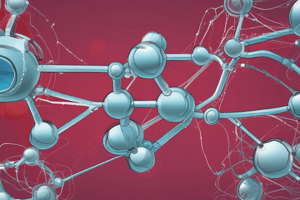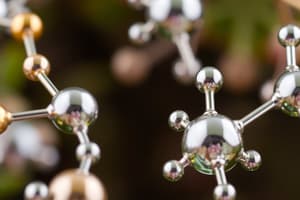Podcast
Questions and Answers
What is the role of natural ferritin in cells?
What is the role of natural ferritin in cells?
Storing and regulating free iron levels, acting as a superoxide dismutase-like nanozyme
How is metal ion transport facilitated in cells?
How is metal ion transport facilitated in cells?
By specialized proteins called transporters
What are the different energy requirements for metal ion transport mechanisms?
What are the different energy requirements for metal ion transport mechanisms?
Some utilize electrochemical gradients, while others rely on ATP hydrolysis
Describe the structure of metal binding sites in biological systems.
Describe the structure of metal binding sites in biological systems.
What is the function of metal ions in enzymes?
What is the function of metal ions in enzymes?
How do metal ions participate in cellular processes?
How do metal ions participate in cellular processes?
What is bioinorganic chemistry?
What is bioinorganic chemistry?
What are the main areas of focus in bioinorganic chemistry?
What are the main areas of focus in bioinorganic chemistry?
What is bioinorganic catalysis?
What is bioinorganic catalysis?
Which metal ions can be involved in bioinorganic catalysis?
Which metal ions can be involved in bioinorganic catalysis?
What is one example of bioinorganic catalysis mentioned in the text?
What is one example of bioinorganic catalysis mentioned in the text?
What are some functions of enzymes using metal ions in bioinorganic catalysis?
What are some functions of enzymes using metal ions in bioinorganic catalysis?
Flashcards are hidden until you start studying
Study Notes
Bioinorganic Chemistry
Bioinorganic chemistry is a multidisciplinary field of study concerned with understanding the chemical processes involving inorganic elements and compounds within biological systems. This branch of chemistry combines concepts from both organic and inorganic disciplines to explain how inorganic components play essential roles in various physiological, pharmaceutical, and environmental contexts. The main areas of focus in bioinorganic chemistry include bioinorganic catalysis, transport of metal ions, metal binding sites, and the presence of metal ions in biological systems.
Bioinorganic Catalysis
Bioinorganic catalysis investigates the role of inorganic cofactors in protein function and enzymatic reactions. These inorganic cofactors can include metal ions like Fe(II), Zn(II), Cu(I), Cu(II), Co(II), Ni(II), Mn(II), and Ca(II). Enzymes using these metal ions often function as oxidases, reductases, lyases, or transferases and are involved in crucial biological pathways such as electron transport chains, DNA synthesis, cellular respiration, and signal transduction.
One example of bioinorganic catalysis is found in the carotenoid cleavage enzymes, which have evolved independently across different species to produce the visual chromophore retinal through isomerization of carotenoids. Another instance involves natural ferritin, a protein responsible for storing and regulating free iron levels in cells, which also functions as a superoxide dismutase-like nanozyme, potentially playing a protective role against reactive oxygen species.
Transport of Metal Ions
Metal ion transport refers to the movement of inorganic elements between intracellular and extracellular environments. This process is facilitated by specialized proteins called transporters, which selectively bind to metal ions and mediate their uptake or release into the cytosol. Transporters can be classified based on their energy requirements, substrate specificity, and function. For example, some transporters utilize electrochemical gradients to drive metal ion fluxes, while others rely on the action of ATP hydrolysis.
Transport mechanisms may involve passive diffusion, facilitated diffusion, or active transport. Passive diffusion occurs when metal ions move through cellular membranes due to their concentration gradient, while facilitated diffusion requires the presence of specific transport proteins. Active transport is an energy-dependent process that involves the action of ATP and transmembrane proteins, such as ion channels and pumps.
Metal Binding Sites
Metal binding sites within biological systems serve various functions, ranging from structural roles to enzymatic catalysis. These sites comprise metal complexes formed by interactions between metal ions and ligands, which may be amino acids side chains, histidine residues, porphyrins, iron-sulfur clusters, or other metal-binding molecules. The structure and properties of these sites play a crucial role in determining their biological function and activity.
For instance, hemoglobin contains four metal binding sites where iron ions interact with oxygen molecules. This interaction allows hemoglobin to facilitate oxygen transport throughout the body during respiration. Similarly, some enzymes utilize metal ions as cofactors to enhance their catalytic efficiency. For example, zinc finger proteins contain zinc ions coordinated by histidine side chains, which help stabilize DNA sequences and regulate gene expression.
Metal Ions in Biological Systems
Metal ions are essential components of many biological processes and have diverse roles within cells. They participate in electron transfer reactions, redox processes, and as cofactors for enzyme activity. Some metal ions also function as signaling molecules involved in cellular communication pathways. In addition, metal ions serve structural roles within biomolecules, such as stabilizing protein structures through ion pair interactions and forming hydrogen bonds in nucleic acid base pairs.
The balance of metal ions within biological systems is tightly regulated, as excess or deficiency of certain metals can lead to toxicity, impaired function, or disease conditions. Imbalances in metal ion concentration can contribute to various diseases, such as Alzheimer's disease, Parkinson's disease, and cancer. Understanding the role of metal ions in biological systems is crucial for developing targeted therapeutics, improving diagnostic techniques, and elucidating the mechanisms underlying health and disease.
Studying That Suits You
Use AI to generate personalized quizzes and flashcards to suit your learning preferences.




